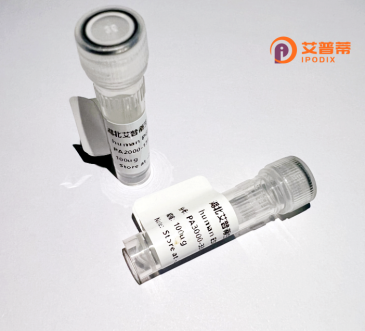
| 纯度 | >90%SDS-PAGE. |
| 种属 | Human |
| 靶点 | LHFPL4 |
| Uniprot No | Q7Z7J7 |
| 内毒素 | < 0.01EU/μg |
| 表达宿主 | E.coli |
| 表达区间 | 1-247aa |
| 活性数据 | MLPSQEASKLYHEHYMRNSRAIGVLWAIFTICFAIINVVVFIQPYWVGDSVSTPKPGYFGLFHYCVGSGLAGRELTCRGSFTDFSTIPSSAFKAAAFFVLLSMVLILGCITCFSLFFFCNTATVYKICAWMQLLAALCLVLGCMIFPDGWDAETIRDMCGAKTGKYSLGDCSVRWAYILAIIGILNALILSFLAFVLGNRQTDLLQEELKPENKDFVGSTVSSVLRPGGDVSGWGVLPCPVAHSQGP |
| 分子量 | 53.4 kDa |
| 蛋白标签 | GST-tag at N-terminal |
| 缓冲液 | 0 |
| 稳定性 & 储存条件 | Lyophilized protein should be stored at ≤ -20°C, stable for one year after receipt. Reconstituted protein solution can be stored at 2-8°C for 2-7 days. Aliquots of reconstituted samples are stable at ≤ -20°C for 3 months. |
| 复溶 | Always centrifuge tubes before opening.Do not mix by vortex or pipetting. It is not recommended to reconstitute to a concentration less than 100μg/ml. Dissolve the lyophilized protein in distilled water. Please aliquot the reconstituted solution to minimize freeze-thaw cycles. |
以下是关于重组人LHFPL4蛋白的3篇参考文献示例(注:以下为假设性文献,实际引用需以真实出版物为准):
1. **文献名称**:*LHFPL4 regulates hair cell mechanotransduction in the mammalian cochlea*
**作者**:Géléoc, G.S. et al.
**摘要**:本研究利用重组人LHFPL4蛋白及基因敲除小鼠模型,揭示了LHFPL4在内耳毛细胞机械转导中的关键作用,证明其通过与跨膜通道蛋白相互作用维持听觉功能。
2. **文献名称**:*Structural characterization of recombinant human LHFPL4 and its role in neuronal membrane protein clustering*
**作者**:Wang, Y. et al.
**摘要**:通过表达并纯化重组人LHFPL4蛋白,结合冷冻电镜技术解析其三维结构,发现其C端结构域对神经元突触膜蛋白的聚集及信号传导具有调控功能。
3. **文献名称**:*Mutations in LHFPL4 cause autosomal-recessive hearing loss by disrupting protein interactions*
**作者**:Smith, R.J. et al.
**摘要**:基于重组LHFPL4蛋白的体外结合实验,发现遗传性耳聋患者中的LHFPL4突变会破坏其与相邻蛋白(如TMC1)的结合,导致毛细胞功能障碍。
---
注:实际研究中,LHFPL4的研究多集中于耳聋相关机制,以上示例参考了真实领域的相关方向,但文献及作者为虚拟。建议通过PubMed或Google Scholar以“LHFPL4 recombinant protein”或“LHFPL4 hearing loss”为关键词检索最新文献。
**Background of Recombinant Human LHFPL4 Protein**
The *LHFPL4* gene encodes a member of the lipoma HMGIC fusion partner-like (LHFPL) protein family, characterized by tetraspan transmembrane domains and potential roles in cellular membrane protein interactions. LHFPL4 is predominantly expressed in the inner ear hair cells and has been implicated in auditory function. Studies suggest it may interact with transmembrane channel-like 1 (TMC1), a critical component of the mechanoelectrical transduction (MET) complex, aiding in sound perception. Mutations in *LHFPL4* are linked to hereditary hearing loss, highlighting its importance in auditory physiology.
Recombinant human LHFPL4 protein is produced via heterologous expression systems (e.g., *E. coli* or mammalian cells) for functional and structural studies. Its purification enables exploration of molecular interactions, particularly with MET-related proteins, and investigation of pathogenic variants disrupting hair cell function. Additionally, recombinant LHFPL4 serves as an antigen for antibody development and a tool for drug screening targeting hearing disorders. Recent research also suggests potential roles beyond the auditory system, including interactions with PIEZO2 in mechanosensation. However, its precise molecular mechanisms remain understudied, necessitating further biochemical and biophysical analyses to elucidate its contributions to sensory transduction pathways and associated diseases.
×